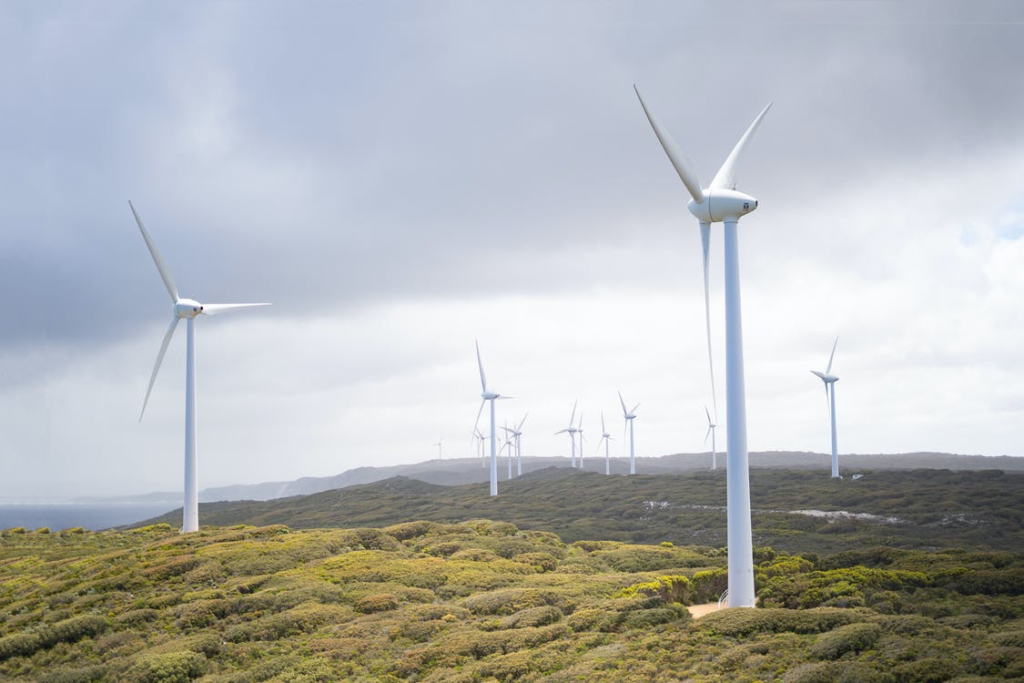Green Energy Helps the Environment
Green energy is a type of energy that is produced from sources that have a low or no environmental impact, or that produce less pollution than conventional energy sources. Green energy sources include renewable energy sources such as solar, wind, geothermal, hydropower, and biomass.
Green energy helps the environment in several ways
- Reduced greenhouse gas emissions: Green energy sources emit fewer greenhouse gases, which are the main contributor to global warming and climate change. By reducing the number of greenhouse gases released into the atmosphere, green energy helps to slow down the pace of climate change.
- Improved air quality: Conventional energy sources such as coal and oil produce air pollutants that can harm human health and the environment. Green energy sources, on the other hand, produce little or no air pollutants, which leads to improved air quality and better health outcomes.
- Conservation of natural resources: Conventional energy sources such as fossil fuels are finite resources, which means they will eventually run out. Renewable energy sources, however, are replenished naturally and can be harnessed indefinitely, helping to conserve natural resources.
- Reduced water usage: Conventional power plants consume large amounts of water for cooling and other purposes, which can lead to water scarcity and environmental damage. Renewable energy sources such as solar and wind power require very little water, helping to conserve this precious resource.
Overall, green energy is an important way to help the environment and mitigate the impact of climate change. By transitioning to renewable energy sources, we can reduce greenhouse gas emissions, improve air quality, conserve natural resources, and reduce our dependence on fossil fuels.

Different Renewable Energy resources are becoming more and more prevalent in the landscape. However, why? What are the advantages of using renewable energy, and how can these advantages assist our economy, our environment, and our health?
This article examines the myriad of advantageous effects that may result from the use of renewable energy sources, such as wind, solar, geothermal, hydroelectric, and biomass power. Check out our article under “The Environmental Impacts of Renewable Energy Technologies” for further details on their detrimental effects, as well as practical suggestions for how these effects might be avoided, minimized, or mitigated.
A significant step toward a more ecologically conscious future is the production of electricity that leaves no trace of carbon behind. If we are able to utilize it to satisfy our need for electricity, industry, and transportation, we will be able to significantly lessen the negative effects that we have on the environment.
Minimum global warming
Carbon dioxide and other greenhouse gas emissions are being released into the atmosphere at an alarming rate as a result of human activities. These gases operate as a kind of thermal blanket. Significant and negative consequences have resulted, from more frequent storms to drought and rising sea levels.
Electricity generation in the United States is responsible for 29% of our country’s total greenhouse gas emissions. Coal and natural gas are the primary sources of most of these emissions.
What is carbon dioxide (CO2)?
Even while carbon dioxide (CO2) is the most common greenhouse gas, it is not the only one. To put it another way, the quantity of pollution produced by various forms of energy is not constant. Carbon dioxide equivalent, or CO2—the quantity of CO2 necessary to create a similar level of warming—is used in order to make comparisons more straightforward.
Most renewable energy sources, on the other hand, do not contribute to global warming in any significant way. No matter how many emissions a technology produces during its lifetime — from production to operation to decommissioning — renewable energy still emits very little to global warming when taken into account as part of its “life cycle.”
In Addition, using biomass, There is a broad variety of global warming emissions associated with biomass-based renewable energy production, depending on the resource and whether or not it is harvested responsibly.

In the United States, Reducing greenhouse gas emissions might be achieved by increasing the availability of renewable energy.
Better-quality public healthiness
The air and water pollution released by coal and natural gas facilities is related with respiratory issues, neurological damage, heart attacks, cancer, early mortality, and a number of other catastrophic problems. The pollution impacts everyone: one Harvard University research assessed the life cycle costs and public health consequences of coal to be an estimated $74.6 billion per year.
In most cases, these negative health effects are caused by pollution in the air and water that clean energy methods do not cause. Wind, solar, and hydroelectric technologies provide power without releasing any pollutants into the atmosphere. Some air pollutants are emitted by geothermal and biomass systems, although the overall emissions are much lower than those of coal and natural gas-fired power stations.
As a result, wind and solar energy do not contaminate or strain water supplies in any way since they compete with other critical water uses such as agriculture and drinking water. Coal mining and natural gas drilling may damage drinking water supplies, and all thermal power plants, including those fuelled by coal, oil, and gas, need water for cooling. Consequently, fossil fuels can have a substantial influence on water resources.

There is a possibility that biomass and geothermal power plants, much like coal and natural gas-fired power plants, may need water for the cooling process. Both the ecosystems upstream and downstream of a hydroelectric power plant might be negatively impacted by the dam’s presence.
Inexhaustible energy
Strong winds, a bright sky, an abundance of plant matter, heat from the soil, and swiftly flowing water are all potential sources of energy that may offer a massive amount that is continually renewed. Although just a tiny portion of the power used in the US comes from these sources at the moment, that might change in the future: Numerous studies have demonstrated that renewable sources of energy have the potential to provide a significant portion of the world’s future need for power, even when taking into consideration the possible limitations of these sources.

Extended economic benefits including Jobs
When compared to technologies that rely on fossil fuels, which are often highly automated and need significant amounts of money, the renewable energy business is more focused on human labor. Installing solar panels requires the assistance of people, while wind farms need the expertise of professionals.
This indicates that more jobs are produced on average for every unit of power generated from renewable sources as opposed to fossil fuels.

There are currently thousands of employments in the United States that are supported by renewable energy. The wind energy industry directly employed full-time-equivalent workers in a variety of capacities, including manufacturing, project development, construction and turbine installation, operations and maintenance, transportation, and logistics, as well as financial, legal, and consulting services. These workers were employed in a wide range of roles. Many firms in the United States are responsible for the production of components for wind turbines, and the installation of wind power projects in the year to a year alone represented an investment of multi-billion dollar projects as well as in another part of the world.
It’s not only wind and solar that employ a lot of people. Year to Year, the solar business employed several people, a 1/4 percent growth over yearly, including positions in solar installation, manufacturing, and sales.
More government funding for renewable energy might lead to an increase in the number of people employed. More than three times as many employees would be created under a 25 percent renewable energy goal by 2025, according to different statistical data.
Additionally, renewable energy business expansion may have beneficial economic “ripple” effects, resulting in additional employment creation. Increased home and company earnings will assist not just the renewable energy supply chain, but also unrelated local enterprises.
Property and income taxes and other payments from renewable energy plant owners are also a benefit to local governments. In addition to lease payments of $2,000 to $5,000 per megawatt of installed capacity (It is also depend region wise), landowners get compensation for power line easements and road rights-of-way when wind projects are developed on their property. Based on the project’s yearly income, they may also be entitled to a share of the profits. Biomass power plant feedstocks may be produced by farmers and rural landowners to provide new forms of extra income.

New renewable energy investments of several billion dollars, few of them in landowner income from? biomass production and/or wind land lease payments, and some amount billion in property tax revenue for local communities were found by the UCS in its analysis of a 25-by-2025 national renewable electricity standard.
Stable energy prices
At this very moment, renewable energy is supplying the United States with power that is both inexpensive and capable of contributing to the price stability of energy in the future.
Although renewable facilities need initial expenditures in order to be built, it is possible for them to run at extremely cheap costs (the “fuel” for the majority of clean energy technologies is free). As a direct consequence of this, the costs of renewable energy sources may remain relatively unchanged over time.

By boosting competition and diversifying our energy supply, increasing our use of renewable energy may help bring down both the price of natural gas and coal as well as the demand for them. A greater dependence on renewable energy sources may also help safeguard customers from the impact of rising costs for fossil fuels.
Consistency and flexibility
Because of their dispersed and modular nature, wind and solar power are less likely to have catastrophic failures. Because distributed systems are dispersed throughout a vast geographical area, it is not possible for a severe weather event to occur in a single site and cause the electricity to be turned off to a whole region. Numerous separate wind turbines or solar arrays make up modular systems. These may be used to generate electricity. The majority of the system’s components may often continue to function normally even if a few of them have been compromised.

Non-renewable power facilities also face the issue of water shortage. Droughts and heat waves may jeopardise electricity production at coal, nuclear, and many natural gas power facilities, which are all reliant on water for cooling. A fossil fuel-powered power station may have to be shut down due to weather conditions, whereas a wind or solar photovoltaic system may continue to produce energy without the need of water. See How it Works: Water for Electricity for additional details.)

Droughts, heat waves, stronger storms, and higher catastrophic wildfires will become more common as a result of global warming, increasing the danger of disruptive occurrences. This calls for more robust and clean technology.
